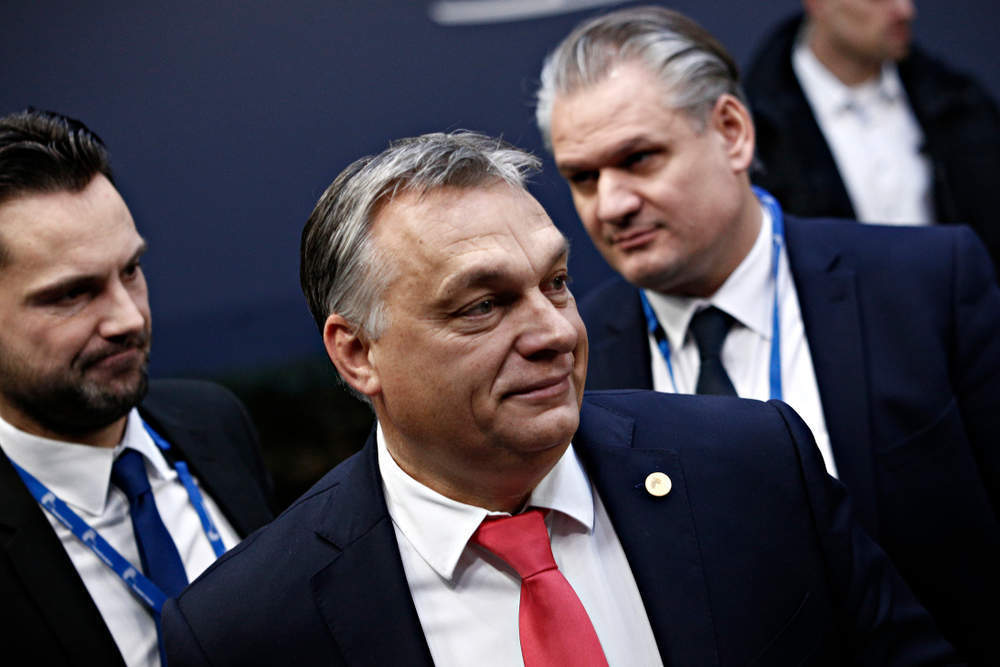
The re-election of Viktor Orban as Hungarian prime minister this month was seen as yet another triumph for populism.
It was Orban’s third back-to-back win since 2010 and it was a landslide. His Fidesz party took a two-thirds super majority in parliament on almost 49% of the vote, with unusually high turnout at 69%.
What, exactly, is populism?
Often used as a sort of sprawling political meta-category, populism is a tricky concept to pin down. Many define it as giving the people what they want (or telling them that they will). Political rivals fire the term at opponents who they deem to have become too popular (the description is frequently levelled at Jeremy Corbyn by his opponents).
A workable, singular definition of populism is the one offered by Cas Mudde, a Dutch political scientist, in 2004.
Mudde defines populism as:
[An] ideology that considers society to be separated into two homogenous and antagonistic groups, “the pure people” and “the corrupt elite”, and argues that politics should be an expression of the volonté générale (general will) of the people.How well do you really know your competitors?
Access the most comprehensive Company Profiles on the market, powered by GlobalData. Save hours of research. Gain competitive edge.
 Company Profile – free sample
Company Profile – free sampleThank you!
Your download email will arrive shortly
Not ready to buy yet? Download a free sample
We are confident about the unique quality of our Company Profiles. However, we want you to make the most beneficial decision for your business, so we offer a free sample that you can download by submitting the below form
By GlobalData
How does this apply to Orban?
Orban’s most recent campaign was based, almost in its entirety, on just two ideas. The first was a portrayal of migrants as an “invasion” that endangers national sovereignty (despite Hungary accepting a vanishingly small proportion of Europe’s migrants). The second was open hostility towards the European Union, the United Nations, and the Hungarian-born billionaire businessman George Soros.
Orban’s politics are predicated on the idea that global institutes and elites (like Soros) are inherently untrustworthy, the systems they facilitate (globalisation, migration) are destructive, and that the ordinary people (of Hungary) must be protected against them.
This political brand fits exactly into Mudde’s definition of populism, given six years before Orban first assumed office.
Is populism on the rise in Europe?
Populist politicians work by dividing everyone into friends or enemies and maintaining that the desires and values of these groups are diametrically opposed. They then casts themselves as a defender, normally against some external threat that the elites and status quo would allow to damage the voice and unity of the people.
For Orban, this threat is Muslim immigration. But it doesn’t have to be. The framework of populism can have almost any political ideology hung upon it. When this is factored in, it becomes easy to see a long history of populist political movements – starting with the US People’s party who, from 1890-96, pitted the rural people against urban elites – shaped to suit specific countries and circumstances. (Arguably, it began even earlier: the revolutionaries who triggered the Revolutions of 1848 across Europe against absolute monarchy definitely had populist traits).
There is evidence that populism has become particularly prevalent in Europe in recent years. A study for the Tony Blair Institute found that the number of populist parties in Europe has almost doubled from 2000 – 2017, from 33 to 63.
In Europe, the political orientation and emphasis of populists varies by region, although there are frequently shared characteristics. In Eastern Europe – which has the largest number of populists in power or coalition – populist parties most often swing to the right. Parties like Orban’s Fidesz in Hungary and Poland’s Law and Justice (PiS) party focus on nationalism based on ethnicity, land or culture and are strongly anti-migration.
In some Eastern European nations, like Hungary and Bosnia, populism is now so entrenched that populist parties compete between themselves for the vote. In Hungary, the main competitor for Fidesz is the far-right, and also populist, party Jobbik. In Bosnia, two right-wing populist parties (the Alliance for Independent Social Democrats and the Serbian Democratic Party) took over half the vote in the 2010 and 2014 elections. This is also the case, although to a much lesser extent, in Slovakia, where three right populist parties and one left one share about 13% of the vote between them.
In Southern Europe, populist parties also have achieved marked success, although they generally swing to the left. Often, austerity politics (which has been damaging for the region in the wake of the Eurozone crisis) is the enemy, with populists making demands for fiscal sovereignty and self-determination rather than the measures inflicted by the political and economic elite. Populism is particularly strong in Greece, one of the states that has suffered the most as a consequence of austerity. There, the ruling Syriza party developed from a variety of far-left movements and, unable to govern with 36% of the vote, formed a coalition with the right-wing populist ANEL party rather than share power with more conventional coalition partners.
In Western and Northern Europe, populists again swing to the right, although they are less pervasive than in other parts of Europe. Although they do not frequently hold power, populists like France’s Marine Le Pen, Germany’s Alternative for Germany party or the Netherland’s Geert Wilders have all made significant gains in the past couple of years. Austria and Switzerland both have populist parties as part of ruling coalitions. Meanwhile, the Italian general election last month saw the anti-establishment Five Star movement became the biggest party with nearly a third of the vote. In typically liberal Scandinavian, populism has also gained ground, with the anti-immigrant Sweden Democrats and the Danish People’s party both the third and second largest parties in their countries respectively. The Baltic nations all have sizable populist blocs in government.
While not party-specific, the success of ‘Brexiteers’ in Britain in 2016 was also a populist success story. The Leave campaign focused on the European Union and ‘Brussels’ as a corrupt elite that was undermining the British people’s sovereignty. The dangers posed by immigration were a frequent talking point and experts were ridiculed and denounced. Brexiteers also strongly embraced political change via a referendum. Direct democracy is one of the strongest tool in any populist’s kitbag, because it allows politicians to claim their direct communication with and endorsement by the people and to side-step the traditional political structures they position themselves against. Since the referendum, the Brexiteers’ response to any political obstacle has repeatedly been: “It’s the will of the people”.
What about elsewhere?
Populism has not just flourished in Europe. Donald Trump’s surprise presidential victory in the United States in 2017 had all the hallmarks of a populist movement. Trump ran his campaign on the idea of not being like other politicians, and a change from the conventional ruling elite (for example, his frequent citing of “Crooked Hillary” and the corruption around her). Once again, immigrants were painted at the enemy. Trump also engaged, with gusto, in a favourite populism activity – inflammatory attacks on independent organisations like the media or the judiciary (remember, in the divisive world of populism, anyone who is not a friend is automatically an enemy). Barely a day goes by when Trump does not tweet about the “biased failing New York Times” or the unfairness of the investigation conducted by Special Counsel Mueller.
Populism in Latin America takes on a slightly different form. Populism in the region was typically inclusive, rather than the exclusive brand normally seen across Europe and America. Latin American populists often demanded that politics be opened up to marginalised and minority people (in Europe, those groups were frequently pushed further away). Latin America has a longer tradition of populism than Europe – running from classical populism in the 1940s and 1960s to the predominately radical leftist populism seen since the 2000s (e.g. Chavez in Venezuela and Morales in Bolivia, both of whom originally based policies around helping the poor through bypassing the traditional welfare state system).
What is the future of populism?
In the last couple of years, Latin American populism has also had a distinct difference to the European brand: it has been in decline. Since 2016, the political mood began to swing back to the centre right. Populist heros of the early 2000s may have bonded with the people but they were fiscally irresponsible and pushed several countries into recession. In the most painful example, Venezuela, Chavez’s governance and then death put the country in chaos and economic freefall. While the appetite for populism may not be completely extinguished – veteran populist López Obrador may well storm to victory in Mexico’s general election this summer – it does seem to be waning across the region.
This, perhaps, is a harbinger of the future of populism in other areas like Europe. Populism is often called the “politics of rage”, and it stems from disillusionment with the current political system. In Latin America, the machine raged against was the extreme inequality caused by colonialism. In Europe, it was years of stagnant middle income growth widening the gap between the haves and the have-nots. This breaks down trust in traditional governance and makes political extremes – like those so frequently chosen by populists – attractive.
Self-defined as an alternative way, populist parties divide opinions and governments, often making it harder for real political change to be pushed through. If populists cannot deliver on the promises they made to their people, such as undoing inequality, they will eventually lose their popularity and power. Equally, though, populist movements arise from deep public dissatisfaction with the status quo. If conventional, moderate politicians do not take heed of these grievances and work to change them, they will never be able to see off the populist threat.







